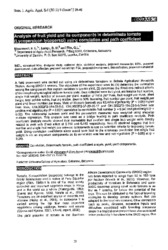Analysis of fruit yield and its components in determinate tomato (Lycopersicon lycopersci) using correlation and path coefficient
Abstract
A field experiment was carried out using six determinate tomatoes at Sebele Agricultural Research Station, during 2010/11 season. The objectives of the experiment were to; (1) determine the correlation among the components that explain variation in tomato yield, (2) determine the direct and indirect effects of the morpho-physiological traits on tomato yield. Data collected were fruit yield, marketable fruit number, single fruit weight, number of trusses per plant, number of fruits per truss, fruit weight per truss, plant height, total soluble solids, fruit dry matter, days to 50% flowering, fruit number per plant, fruit weight per plant and flower number per truss. Yield of Sixpack (control) was 62.4t/ha significantly (P < 0.05) higher from lines, CNL3022F2-154-22-9-3, CNL3022F2-37-29-10-17 and CNL3022F2-154-22-5-5.Yield was positive and significantly (P < 0.001) correlated to marketable fruit number (r = 0.64) and plant height (r =0.52). The relationship between yield and the parameters measured was analysed using stepwise multiple regression. This analysis was used as a bridge leading to path coefficient analysis. Path coefficient analysis results showed that marketable fruit number and single fruit weight were directly related to yield with direct effect of 0.752 and 0.446 respectively. Results obtained suggest that fruit number and single fruit weight are relevant components to use as selection criteria for improving tomato yield. Using correlation coefficients alone would have lead to the erroneous conclusion that single fruit weight is not an important components as its correlation was low and not significant (P > 0.05) at (r =0.30).

